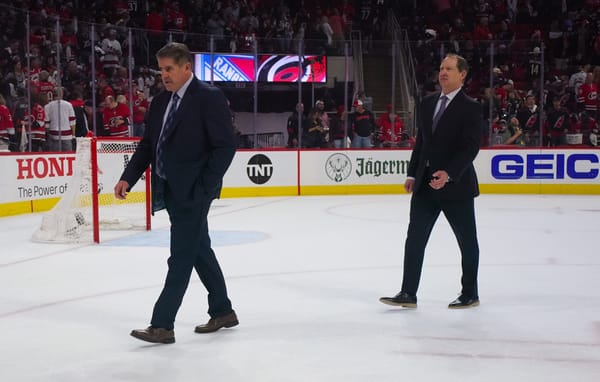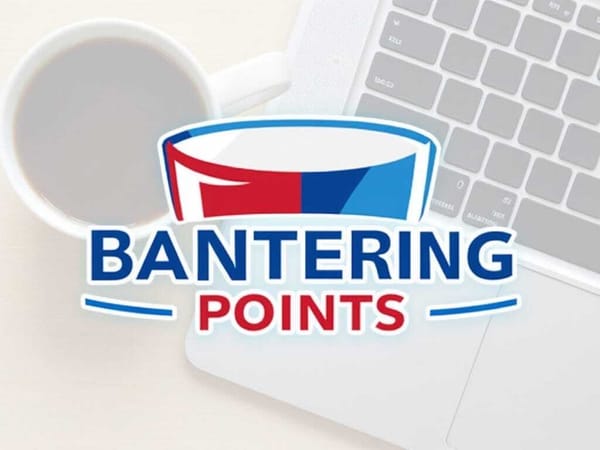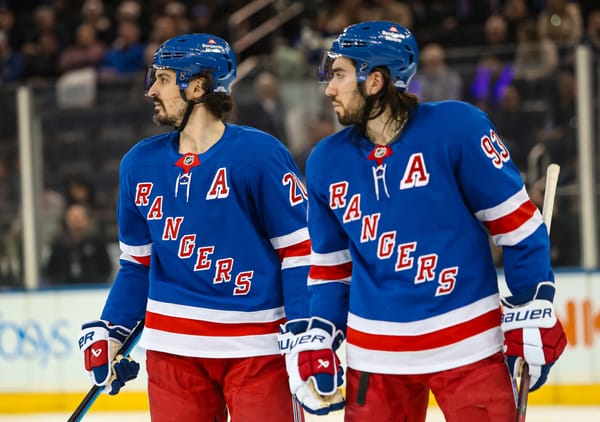John Davidson Comes to New York With Experience and Finds Himself in Familiar Territory
The veteran executive and former New York Ranger has gone through two rebuilds, and hopefully the third time is the charm for winning a championship.
The New York Rangers naming John Davidson President is exciting for a number of reasons. For many, that reason stems from who he is and what he means to the franchise. But above all else, that excitement should revolve around his qualifications for the job and how he can help take the Rangers to the next level.
There are still questions on the direction the team will take under Davidson, but so far it’s become clear that he wants to be hands on in the process, while still allowing general manager Jeff Gorton continue the rebuilding process he started.
To get a better sense of Davidson, the team executive, and how he will look to make his mark with the Rangers, we reached out to Alison Lukan of The Athletic, and Pale Dragon, the managing editor SB Nation’s Columbus Blue Jackets affiliate, The Cannon. We also juxtaposed some things Davidson has already said with that context in mind.
How involved was he in the day to day with the Blue Jackets?
Alison Lukan:
In all of this, it’s important to remember where the CBJ were when JD joined the organization. They had a bad team and a weak reputation within the league and among players. The first and most important thing JD brought — and continued to provide — was credibility.
His best work was hiring people to do their jobs, and then get out of the way. And then communicating with ownership on behalf of his team.
Those hires include Jarmo Kekalainen, who Davidson hired as general manager in 2013; he was the first European born general manager in the NHL and had previously worked with Davidson in St. Louis.
This is something that will apply to Gorton, as it makes little sense to try and overhaul the current process. Davidson briefly described his relationship and familiarity with the Rangers’ GM during an interview on The Michael Kay Show, and for the interim I don’t expect anything to change on that front.
However, it is likely that we will see some changes to the rest of the organization.
Lukan:
The second thing he did was use that (deserved) credibility to serve as a communication channel / layer between ownership and hockey ops. JD could articulate the why’s and how’s of what hockey ops wanted / needed to do and gain ownership’s support and buy in.
And then of course there is the public face the organization needed. JD was a calming and inspiring presence for fans and was able to hold things level on that front as well. Plus — people just like him.
Davidson will serve a similar role in New York, as he will be managing up to ensure that team owner James Dolan focuses on the New York Knicks among other things.
Given Davidson’s history with the organization, he shouldn’t have a problem being the person in the middle of Dolan and Gorton when it comes time to make free agent offers, or make blockbuster trades. That familiarity should ease the transition between presidents, and the trust the organization has in JD should allow him to lead the Rangers without much interference from ownership, similar to how they operated with Sather in charge. Davidson will set the tone for the Rangers moving forward.
Also as he did in Columbus, Davidson’s presence should be both calming and inspiring to fans, especially those who grew to know him through his connections to the team over the years.
The Cannon:
When it came to roster moves, Jarmo was the primary decision maker. JD was just another experienced voice in the room providing counsel. JD served as an important buffer between management and ownership. Ownership was left out of hockey decisions (team president Mike Priest likely meddled too much on the hockey side prior to JD’s arrival), and JD was the one in charge of justifying big money moves to those cutting the checks.
Meddling shouldn’t be an issue in New York, as Dolan simply wants to be the one who “signs the checks” when it comes to the Rangers.
On a more symbolic level, JD”s presence brought some much-needed credibility to the Blue Jackets franchise. It sent a signal to the rest of the league that there was finally a grownup in charge. Locally, he gave Columbus fans confidence that finally the team was run by someone who had built a successful team elsewhere. He was a constant presence at press conferences and in marketing campaigns for the team. In recent seasons, however, he has been less visible in public as Jarmo has grown more comfortable in that role, and the players are popular enough to market the team themselves.
Given his gregarious nature and broadcasting background, Davidson won’t have a problem being the vocal face of the organization — something Sather didn’t do much in his tenure — so JD will likely be seen and heard more in five years than Sather was in his 19-year tenure.
As the rebuild goes on it is important to communicate to the fans, and the Rangers got off on the right start in February 2018 by sending their season ticket holders a letter before releasing it to the rest of the fans. In 2019 there are so many avenues in which fans can articulate their feelings, so teams can never feign ignorance to how their fans are feeling.
This is not to say that teams should make or not make moves based on the whims of their fans, but communicating important decisions made is key. Since becoming an executive, JD has never been shy about being interviewed or appearing on podcasts, and that’s something that should, and hopefully will, continue in his new role.
By being more open and communicative, it should help bridge the gap between fans and the team. As the Rangers, a historic Original Six franchise, they really haven’t had to try to sell fans on their message or process. But between their rebuild and the changing media landscape, that has to be a priority. Coming from a smaller market team like the Blue Jackets, Davidson seems to have that understanding which should help the Rangers evolve.
What is your opinion on how JD builds/staffs a front office? Do you think he had a fairly innovative approach in his hiring?
The Cannon:
One thing that stands out is the stability he brought to the front office and coaching staff. He fired the GM he inherited (Scott Howson) halfway into the first season, and Jarmo Kekalainen has been the GM ever since. Most of Jarmo’s assistants have been the same since he did a full overhaul of the scouting staff after his first draft. There have been only two head coaches in the seven seasons of the JD era. Success makes it easier to avoid firing, but I also think the success can be partially credited to that stability.
This is something worth keeping an eye on, as scouting is one area the Rangers certainly will look to address. During the same interview on The Michael Kay Show, scouting was one area addressed by Davidson that he’d look at in his new role.
Gordie Clark currently runs the draft for the Blueshirts, and he’s been in that role since July 23, 2007. He originally joined the organization in 2002. Also part of the scouting department is Kevin Maxwell — director of professional scouting since 2011, originally hired in 2008 — and Nickolai Bobrov who has been the director of European scouting since 2015. Then there are the individual scouts who report up, but these three are focus of the Blueshirts’ scouting brain trust.
In recent years the Rangers have certainly drafted their fair share of players from Europe —a shift from a strategy which previously saw them draft a lot of American and North American players — and it wouldn’t be surprising if Bobrov gets a promotion in the near future.
This because the case as the 43-year-old is more likely to remain with the rebuilding franchise for the long haul than the 66-year-old Clark.
This is not to say that everyone on staff should be pushed out, but departures like Jim Schoenfeld ahead of JD’s hiring — someone who was very close to Sather — likely signals that there could be at least a small shakeup operationally.
It is also entirely possible that individuals like Clark, Maxwell, and Bobrov stay in their current roles — at least through the upcoming draft — but don’t be surprised if/when Davidson brings in his own personnel, which is exactly what he did by hiring Kekalainen after he joined the Blue Jackets.
Lukan:
I’d say Davidson was innovative in that he hired the first ever European GM and then helped build a front office team that he trusted to do the intricacies of the day to day. That’s not to say JD was absent, he most certainly was present. It’s overall more a comment on how he led.
Pale Dragon also mentioned the innovation of hiring Kekalainen as the first European GM. It was a risk JD took because of his relationship working with him in St. Louis. The move to date has appeared to be a good one, as the Jackets have reached the postseason a few times and won their first series in franchise history on his watch after a bold approach at the 2019 trade deadline.
The Cannon:
Much of Jarmo’s draft success has come through finding European gems in the later rounds (like Markus Nutivaara). On the flip side, he famously passed on his countryman Jesse Puljujarvi to draft Pierre-Luc Dubois and that was clearly the right call.
While that GM hire was groundbreaking, it was also conventional in many ways. Jarmo worked for JD in St. Louis. Prior to that, Jarmo played college hockey in the US, played in the league, and scouted for Ottawa and St. Louis. He’s an NHL lifer like most other GMs, aside from a couple years managing a team in Finland prior to taking the Columbus job.
Therefore I don’t expect JD to rock the boat in New York. He’ll take time to get to know everyone and let them prove their worth. If he makes changes, it will be to bring in established NHL people.
What are your thoughts on his overall approach? Was he a traditionalist? Was he open to more innovative concepts and analytics?
Alison covered a lot of this in earlier questions, and this snippet focuses on the last part of the question.
Lukan:
JD was not risk-averse (i.e. the Johansen - Jones trade) — which is sort of a little bit of being innovative! ;) He let Kekalainen expand the focus on analytics etc and supported that as part of his team’s operations and culture.
The Columbus Blue Jackets’ use of analytics is something Lukan cover in-depth in 2017, and it is worth checking out this story for more details. Her article focuses more so on Kekalainen, but it is an area Davidson brought up unprovoked during his interview on The Michael Kay Show embedded towards the beginning of this story.
The Cannon:
I definitely think he’s a traditionalist. I think that’s the source of his popularity across the league: he’s an old school hockey guy. The Blue Jackets do have an analytics department, but it’s not clear if they’ve made any breakthroughs or if the coaches and players would use it if they did. Torts claims to not be a fan of advanced stats, but at the same time he cites on-ice scoring chances for and against when evaluating players, so clearly he grasps some of those concepts even if he doesn’t realize it. The team hired a high performance coach, Nelson Ayotte, who has had a huge impact on keeping players healthy and well-conditioned. That led to things like ending morning skates on game days, and staying overnight after road games to avoid disrupting normal sleep patterns.
JD being a traditionalist isn’t surprising, but it is fair to say that he’s someone who has changed his approach over the years. Unlike most executives in the league, Davidson’s entire career has been during the salary cap era, and the rules that came out of the 2004-05 lockout. That means that he’s had to manage and operate in a “modern NHL” and adapt as trends have come during the league.
Davidson recognizes the nature of the game is changing, especially when it comes to building a team.
It is refreshing to hear someone talk about free agency honestly, and how there needs to be thought about the type of players worth adding. It would be very easy for the Rangers to take advantage of their cap space, but Davidson’s mention of the league being full of players in their mid 20s and below suggests that the team won’t just sign players aimlessly.
Overall there’s a lot of information to take in, but it is clear that Davidson is going to be hands on in the rebuild. He is going to work with Gorton to make sure the rebuild continues to make progress, and he hopes to use his experience of going through this process during his time in St. Louis and Columbus to help the Rangers come out of it as a Stanley Cup contender.
A team president may not have his hand in the day to day, but ideally he has his footprint in their season accomplishments. Davidson joined two teams outside of the playoff bubble, first the Blues in 2006, then the Blue Jackets in 2012. While the Blues may not have had the success that all could have hoped for in Davidson’s tenure, when building a team up, the results can be delayed since the process relies on future assets that can take years to develop. For that reason, we included the five years after Davidson left St. Louis, as reflected by the points connected by the dashed line.
Columbus, on the other hand, has improved since Davidson’s start, as they’ve taken strides in recent years by making the postseason, and this year winning a series for the first time in franchise history. Now he is in New York, and ready to do it all again, and hoping to collect some championship hardware.
Davidson has competed for the Stanley Cup once in his career, as a player during the 1979 Final, and he comes to New York for what is likely his final job in hockey. He comes to the franchise with energy and motivation to bring a title to the city, and being around the team as a broadcaster in 1994 gives him insight to what that feels like.
JD’s been a fixture in NHL hockey for quite some time and enters an opportunity where he bring his knowledge to a team with practically unlimited resources. The team will have to abide by the salary cap when it comes to players, but Dolan is prepared to give Davidson whatever he needs to build a winner.
John Davidson said James Dolan told him whatever he needs in this job as the Rangers president he is going to get. He said he loved to hear that because that’s what you need to build a perennial Stanley Cup contender.
— Dan Rosen (@drosennhl) May 22, 2019
This extends to a more robust scouting and analytics department, rebuilding the Hartford Wolf Pack, and it is fair to say that should extend to having a strong ECHL affiliate that can be used as a feeder system when the team signs various free agents out of college and various Junior hockey systems.
Talk is cheap, but there’s no reason why Davidson can’t be successful in New York. The Toronto Maple Leafs are an example of a big market team that has done things the right way, and they’ve laid the groundwork to have success at the NHL level. The Tampa Bay Lightning are a smaller team that have done this as well.
As the Rangers rebuild, they don’t have to reinvent the wheel since there are models to follow — including those that Davidson has played a key role in. Though, they may have to adjust the models and examples set by other teams; but Davidson, who is at the head of the process, seems to recognize the importance of adapting and growing.
The draft is the next step, free agency the following. With each step, there should be a better indication of the team’s direction, and Davidson’s influence on that. The Rangers will be patient in this process, and it will be interesting to see what moves are made, when the time is right, now that Davidson has an owner with considerably deep pockets.
Based on his knowledge of the game, years of experience with St. Louis and Columbus, and understanding how important of adapting, by bringing on Davidson the Rangers have taken the first step in what stands to be a pivotal offseason.




